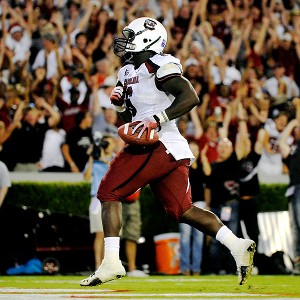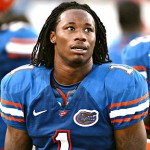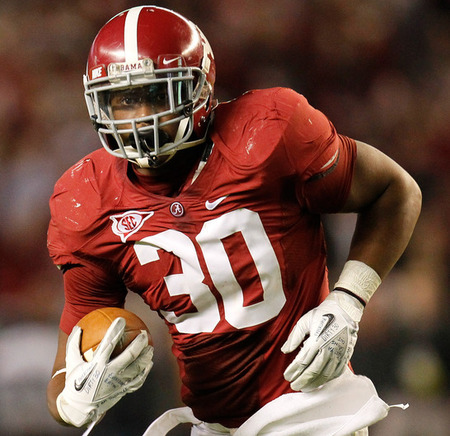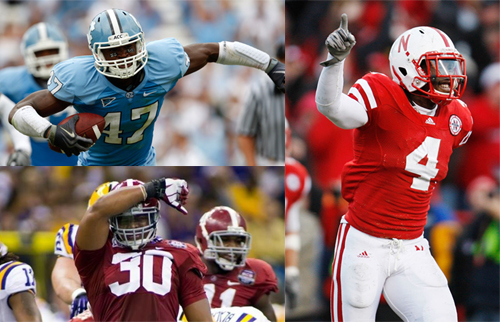
We haven't had a picture of this guy on the blog in a while
Written by Kip Earlywine
I think I’m pretty much done with the draft spotlight series for this year. In the end, I scouted a little over twenty players in the last month, and spent (on average) about five hours apiece doing the write-ups for each player, and that’s on top of the 15 quarterbacks I reviewed in my late round quarterback series earlier this year. Before I shut things down and slip into an exhaustion coma, I thought that it might be fun to attempt a “big board” for each position after doing all the work and research over the last few months.
I’m only going to include quarterbacks, running backs, and linebackers, since I spent 99% of my time researching those positions and didn’t really cover anything else. Additionally, I’ll include my best guesses on what John Schneider’s big board might look like for those positions. Let me be clear that while Rob and I have heard a handful of specific details about players they like, most of this list will just be guesswork. Bear in mind that all of my rankings are tailored to Seattle’s specific scheme needs (point guard quarterbacks, fast linebackers or coverage oriented linebackers, and zone blocking scheme friendly running backs). I’ll break this down into three different posts. For now I’ll start with quarterbacks.
My top ten quarterbacks in the 2012 draft:
#1: Andrew Luck (deserves to be drafted: #1 overall)
It’s hard to tell how good Luck is under duress, because he was almost never under pressure at Stanford thanks to what was arguably the best offensive line in the country. That pretty much sums up the totality of my reservations regarding Luck, who’s been the golden boy of college football the last two years. Any quarterback can bust, but Luck is the safest quarterback with the highest potential to come out since at least Carson Palmer.
#2: Robert Griffin (deserves to be drafted: top 10 overall)
I don’t want to be the guy who bets against Griffin. I don’t know if I’ve ever seen a quarterback with his elite combination of intelligence, athleticism, work ethic, arm strength, and accuracy. That said, Robert Griffin might be the most over hyped quarterback of all time. His hype is understandable, but it is not deserved. He has way too many red flags to justify the price Washington paid for him. His pocket presence and “escapability” aren’t as good as a lot of people think despite the athleticism. His mechanics and footwork need serious work. He’s a lanky 215 pounds and was an injury magnet in college. He also came from a college system that was designed to exploit college level athletes. For all the crap Darron Thomas gets for having superior athletes and easy plays, people don’t talk about this problem at all when discussing Griffin.
Overall, I find him to be easily inferior to Cam Newton as a prospect. It’s kind of amazing how much the “diva” label matters to GMs, some of whom felt Newton was not worth a top twenty pick (oops). Griffin is no diva, in fact, I’d go so far as to say he’s the coolest guy in the whole draft. I think his likable nature may have sparked his meteoric rise up draft boards as much as anything else.
Regardless, Griffin is a worthy top 10 pick on potential alone and I really do wish him the best. I’m not expecting him to fail, but I guess you could say I’m more prepared for it than most because his risks are very real and not being talked about nearly enough.
#3: Russell Wilson (deserves to be drafted: round 3)
After Luck and RG3 leave the board, there is a massive drop off in the quality of the quarterbacks. Most people have Ryan Tannehill third, with many even swearing to believe he’s worth a top 15 pick. I know it’s self-serving for Russell Wilson to compare himself to Drew Brees, but I think Wilson has a point. Brees stands about 5 inches shorter than the average NFL lineman. Wilson stands 6.5 inches shorter. Does that extra inch and a half matter when even Brees has to use passing lanes at his height? Really, any quarterback under 6’2″ is probably going to be a “passing window” quarterback in the NFL. Jeff Garcia (6’1″) and Michael Vick (6’0″) were very effective in a point guard quarterback scheme and had to use throwing windows because of their height.
Not all short quarterbacks can get around this problem, but Russell Wilson has already proven that he can. His line at Wisconsin was one of the tallest in the country and taller than many NFL lines, and yet he had almost zero height related problems because the scheme and his own talent allowed him to find throwing lanes to look through. I honestly worry more about Wilson’s stats being inflated by Wisconsin’s high completion rate offense more than I worry about his height. If Wilson goes to the right kind of offense, namely an offense just like Seattle’s, I believe that at a minimum he’ll be one of the league’s best backups, with a chance to be a good starter.
Wilson is either NFL material or he isn’t, but I think if he passes that test he’s going to be a good NFL quarterback. Wilson probably won’t be drafted in the 3rd round, he’ll probably go in rounds 4-6, but quite honestly I would not complain if the Seahawks pulled the trigger on him there. Wilson has the talent to fundamentally change how the NFL looks at sub-six foot tall quarterbacks.
#4: Chandler Harnish (deserves to be drafted: round 3)
Concerns about height (6’1″) and level of competition aside, Chandler Harnish is simply the best quarterback in the draft that none of the big name draft analysts are talking about. His pocket presence, elusiveness, mobility, accuracy, confidence, mechanics, decision-making and his general smooth looking play are all NFL caliber. Some have criticized his arm strength but I just can’t agree. His passes arrive with zip and his deep ball isn’t Locker/Mallett territory by any means but it’s good enough. My only real concern with Harnish was that he ran a disappointing 4.76 forty at the combine, which makes me wonder how much of a hit his field speed will take when going up against NFL defenses. Harnish may not have ideal measurables, but it’s clear that the guy can flat out play. The way he plays the game reminds me of Steve Young.
#5: Ryan Tannehill (deserves to be drafted: round 3)
I remember right after last year’s draft, Rob did a piece on potential quarterbacks to look out for in 2012. Near the bottom of the list was Ryan Tannehill, a guy that nobody was talking about. I wasn’t impressed by a lot of the options, but Tannehill jumped out at me immediately as a guy with first round potential. As we’re starting to find out, a lot of NFL scouts were fully aware of Tannehill’s talents, with some of them claiming to grade Tannehill in the top 15 even before the 2011 season. I believe them. Tannehill’s best tape was from 2010, so it makes sense they would like him after his best season.
Unfortunately, Tannehill did not develop as he needed to in 2011 and even took a few steps backward. I like the guy and he certainly has NFL pro-bowl potential physically, but his decision making is deeply flawed and he might require years of development. In a way, he’s a bit like this year’s Colin Kaepernick, although each quarterback needs development time for totally different reasons.
#6: Darron Thomas (deserves to be drafted: round 4)
I’ll admit some bias on this one. Not Oregon Duck bias, because I’m not a Duck’s fan. No, I suffer from a Keith Price bias, as Keith Price’s 2011 season developed my thinking on quarterbacks more than any quarterback in a long time. Thomas is the closest thing in this draft to a Keith Price option. Both are lanky, semi-athletic quarterbacks with a little inconsistency in their deliveries. While Thomas gets a lot of bad press for being the quarterback of a gimmick offense, he still played a point guard quarterback role very similar in nature to the role Keith Price played last year. Thomas looks very comfortable progressing through reads and makes mostly good decisions (unless Cliff Harris is involved). In a lot of ways his flaws are less egregious than Robert Griffin’s (particularly footwork and mechanics), but because his ceiling isn’t as high he gets crucified for his problems while Griffin gets a free pass.
I have a ton of respect for Chip Kelly, but he’s in the business of competing for national championships, not possibly throwing games away to develop his quarterbacks. I can’t help but wonder how perceptions of Thomas would differ if he had put up close to the same numbers he did the last two years while playing in Steve Sarkisian’s pro-style offense, which given the similarity of the quarterback roles, doesn’t feel like a stretch to me. Don’t get me wrong, Price is the better quarterback, but Price is 6’1″ and finished last season at 185 pounds. Darron Thomas is 6’3″ and weighs 220, both being “franchise quarterback” measurements. If you have that kind of size with above average mobility and performed well for a major school, you should not be allowed to be an afterthought. I’m not glossing over Thomas’ flaws- that’s why he’s this far down the list. But I think a lot of people have fallen into the trap of ignoring his talents because he’s got some imperfections and because the prevailing attitude about him is so stiflingly negative (or as I like to think of it, “Tedford quarterback” syndrome).
Do I think Thomas is likely to be a good starter? Probably not, but I do think he could become one of the league’s better backups in a point guard quarterback scheme. To me, that’s worth a 4th round pick. Given how pervasive the groupthink on Thomas is though, it wouldn’t shock me if he went undrafted. Which is silly, I think. Thomas has some talent. This isn’t Jordan Jefferson we’re talking about here. I see some natural talent in Thomas, and a lot of stuff to work on, but also a ton of room for development.
#7: Brock Osweiler (deserves to be drafted: round 4)
I should probably have Osweiler a lot higher than this. Osweiler passed for 4000 yards last season and threw 28 touchdowns. He’s 6’7″, but doesn’t come with the typical athleticism drawbacks of an overly tall quarterback. Purely in terms of potential, Osweiler could become an NFL quarterback that resembles Big Ben: big, tough, decently mobile, and efficient. I think that if Pete Carroll could get any quarterback in the NFL, Big Ben would be on the short list because of how his toughness and efficiency compliments a run first offense.
I have a few problems with Osweiler though that provide me with a healthy skepticism. First is that he was really inconsistent. He’d have some games where he’d look like 1st round material but other games where he looked like garbage. His accuracy is also very inconsistent and at times he’ll miss the target by a lot, which reminded me a little of Mike Teel when he was here. Osweiler also had 13 interceptions last year (one per game), and that’s simply too many. Another thing is that I’m not seeing natural leadership from Osweiler on the field, or at least not leadership that is on par with most other draftable quarterbacks. It’s superficial, but I get a bit of a Jimmy Clausen vibe from Osweiler in interviews- though I’ll at least give him credit for trying to be likable, even if it’s incredibly rehearsed sounding.
I also wonder why Osweiler would leave Arizona State after only one season of starting, especially with all the problems he has to work on. Darron Thomas catches a lot of crap for the same thing, but Thomas started for two years, not one, and even if he had returned in 2012 the odds would be against him boosting his draft stock even if his performance improved. If Osweiler had returned to Arizona State and improved, he could have easily become a 1st round pick next year. By declaring now and settling to be a round 2-4 pick, that makes me wonder how much confidence he has in himself. It definitely feels like Osweiler is cashing in now to cut his losses. I’d have a lot more respect for him as a prospect if he went the Landry Jones route instead.
#8: Brandon Weeden (deserves to be drafted: round 4)
We’ve seen Weeden before. His name was Chris Weinke, the oldest player to ever win the Heisman. He entered the 2001 draft at 28 years of age just like Weeden. Despite having second round talent, Weinke was a 4th round pick. He was a solid backup for a few years, but only briefly started and in the end, didn’t amount to much.
As much as Brandon Weeden would like everyone to believe that his age and maturity will allow him to walk into the NFL without a rookie hangover, history has proven otherwise. Most recently, we’ve seen something similar with Danny Watkins- a player that Seattle had a lot of interest in and very nearly drafted (the Eagles snatched him up a few picks before the Seahawks). Watkins was 26 years old, but made the argument that he was more NFL ready because of his age. Instead, Watkins was a brutal flop in his first season, getting benched early in the season and even admitting publicly that he was overwhelmed and not even close to being ready. I’m not pronouncing Watkins a bust, but I think it’s safe to say that his argument about being NFL ready because of his age has been thoroughly discredited by this point.
Other than some inconsistent accuracy, I found Weeden to be a promising quarterback, but his age will almost certainly limit him to being a short term backup. His talent is better than a 4th round grade, but his circumstances and limited shelf life drop his grade considerably.
#9: Kirk Cousins (deserves to be drafted: round 5)
Cousins, a quarterback with remarkable eloquence off the field but limited ability on it, is a bit like this year’s Ricky Stanzi, although quite honestly I liked Stanzi a lot more when I scouted him last year. You can read my review of Cousins in more detail here, but the main thing is that he’s a mediocre quarterback despite throwing most of his passes less than 10 yards. His upside in the NFL is Trent Edwards. Stanzi was a 5th round pick last year. I’d feel a little bad for him if Cousins was drafted earlier despite being inferior, and it looks very realistic that could happen.
#10: Austin Davis (deserves to be drafted: round 5)
I wish I knew more about Austin Davis. I’ve only been able to scout one full game. My initial impression is mostly positive. In terms of size he’s similar to Chandler Harnish, and while he’s not the athlete Harnish is, he’s a leader who is money in the red zone. He has the look of a point guard quarterback. If I knew more about him, I’d probably have him higher than this.
The front office’s top 10 quarterbacks (my guesses):
(estimated draft grade in parenthesis)
#1: Andrew Luck (1st round grade)
I’d assume they’d have him ahead of RG3. While Luck gets compared to Manning a lot I think he probably compares the closest to Big Ben because of his size and accuracy, and as said before, I think Seattle is looking for a Big Ben type quarterback.
#2: Robert Griffin (1st round grade)
Griffin is a perfect fit for the point guard role and might have more upside than Luck, and this front office values upside more than most.
#3: Brock Osweiler (2nd round grade)
I’ve heard from two sources that the Seahawks are huge fans of Osweiler, which makes a lot of sense. I’m not that big a fan of his, but this front office likes players with upside and they like value. Osweiler has 1st round upside with a 2nd or 3rd round price tag. He fits the “tough guy” quarterback mold. Their interest in him makes a lot of sense.
#4: Ryan Tannehill (2nd round grade)
As said before, Tannehill has a lot of similarities with Colin Kaepernick. Kaepernick was Seattle’s 2nd highest rated quarterback in the 2011 draft. From what we’ve heard, Seattle does like Tannehill but seems to like Osweiler a lot more.
#5: Russell Wilson (4th round grade)
I’ve also heard that Carroll “loves” Russell Wilson. Not at all surprising. The Seahawks are one of the few teams that run a scheme tailored for Wilson’s strengths and weaknesses, and there may not be a quarterback in the 2012 draft who “tilts the field” as much as Wilson does with his confidence and leadership. He’s also a guy that could potentially be available in the late rounds, which scores bonus points as I feel it’s unlikely Seattle will draft a quarterback early. It’s worth pointing out that last year we heard of several prospects that the Seahawks thought well of but scratched off their boards completely despite that (Marvin Austin and Adrian Clayborn being a couple examples I remember). So just because Seattle really likes Wilson doesn’t necessarily mean they’d draft him (that said, I hope they do).
#6: Kirk Cousins (4th round grade)
I wonder if Cousins might be much higher than this. We’ve heard that (unsurprisingly) the Seahawks are big fans of Cousins, and if Cousins reaches the 4th round, don’t be surprised if the Seahawks end up taking him. I hope they don’t, personally, but I think it’s very possible. I’m putting him below Wilson for now since the info we’ve heard was very positive for Wilson and seemingly more positive than Cousins.
#7: Chandler Harnish (5th round grade)
Here is where the guessing really begins. Seattle’s draft boards are always a little weird- John Schneider is a guy who marches to the beat of his own drum- though who can blame him with the results he’s had? I’ll put Harnish in this spot as to me he’s clearly the best of the rest at this point and fits the offense like a glove. He was also the only quarterback in the draft that was given an invite to visit the team.
#8: Austin Davis (6th round grade)
In an interview around the time the combine was going on, John Schneider listed Harnish and Davis in the same breath. Seattle was known to have sent a scout for one of Southern Mississippi’s games last year, and I can’t imagine it was to scout anyone else. Davis seems to be NFL adequate in terms of tools and he oozes strong intangibles. He’s another “tilt the field” kind of quarterback. It would be pretty cool if Seattle drafted him. Austin Davis was kind enough to give an interview to Rob on this blog last year, and we don’t exactly have a ton of interviews on this site. So his becoming a Seahawk would be kinda neat.
#9: BJ Coleman (6th round grade)
As much as I dislike Coleman as a prospect, it’s hard for me to not see him being on the Seahawks’ radar. He doesn’t have much talent, but he does have terrific measurables without being publicly condemned as damaged goods like Jordan Jefferson.
#10: Bo Levi Mitchell (7th round grade)
I’ll end this list on a bit of a wildcard. The Seahawks have not shied away from small school talent. Mitchell made huge strides in each of his last two seasons, including a FCS national championship season in 2010. I’ve only had a chance to see him in his near upset on the road at Washington, but he’s similar in size and stature to Drew Brees and has terrific pocket presence and elusiveness. He doesn’t have a world class arm, but it didn’t stop him from making “wow” throws in that game. He’s a guy that might be totally off the radar of most NFL teams, but I doubt he’s off the Seahawks radar as the Seahawks do a lot of homework on smaller schools. I’d probably have Mitchell higher on both these lists if I had more of his tape to go off of.
























 #19 Michael Floyd (WR, Notre Dame)
#19 Michael Floyd (WR, Notre Dame)


















